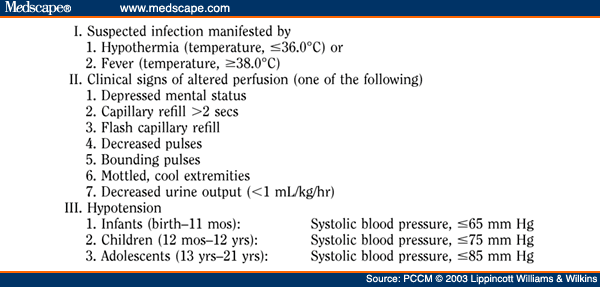Septic shock is a serious medical condition caused by decreased tissue perfusion and oxygen delivery as a result of infection and sepsis, though the microbe may be systemic or localized to a particular site It can cause multiple organ dysfunction syndrome and death. Septic shock is most common cause of death in intensive care units.Mainfestation of sepsis include those related to the systemic response to infection(tachycardia,tachypnea,alteration in temperature and leukoctosis) and those related to organ system dysfunction(cardiovascular,hematological,renal,respiratory and hepatic abnormalites.
Causes
- Sepsis
- Bacterial
- Viral
- Parasitic
- Fungal infections
Risk Factors
- Age: newborns and people over age 50
- Individuals with weak immune system, Low white blood cell counts,Chronic diseases and previous injury.
Symptoms
- Irregular blood pressure
- Chills
- Confusion
- Reduced alertness
- Fever, which may be followed by a drop in body temperature
- Warm, flushed skin
- Rapid, pounding heartbeat
- Rapid breathing
- Reduced urination
- Kidney failure
- Lung failure
- Heart failure
- Blood clots
Investigations
- · FBC
- · Urine dipstick and sample for microscopy, culture and sensitivity
- · Renal function test
- · Liver function test
- · Glucose - hyperglycemia can be present.
- · Clotting screen, including D-dimer and fibrinogen testing
- · Blood culture and sensitivity
- · Radiology - including CXR, abdominal ultrasound and CT
- · Arterial blood gases
- · More invasive investigations can be done looking for a source of infection such as lumbar puncture, bronchoscopy, laparoscopy, lymph node biopsy, etc.
 |
Criteria for diagnosis of septic shock |
Treatment
l. IV antibiotics (broad-spectrum) at maximum dosages
2. Surgical drainage if necessary
3. Fluid administration to increase mean BP
4. Vasopressors may be used if hypotension persists despite aggressive IV fluid resuscitation.
a. Dopamine is typically the initial agent.
b. If dopamine does not increase the BP, norepinephrine may be given.
References
1. http://www.patient.co.uk/doctor/sepsis-septicaemia-pro [Accessed 28 April 2015].
2. Mayo, 2014. Sepsis. [Online] Available at: http://www.mayoclinic.org/diseases-conditions/sepsis/basics/symptoms/con-20031900 [Accessed 28 April 2015].
3. nhs.uk, 2015. Septic shock. [Online] Available at: http://www.nhs.uk/Conditions/Septic-shock/Pages/Introduction.aspx [Accessed 28 April 2015].
4. Ratini, M., 2015. Sepsis (Blood Infection) and Septic Shock. [Online] Available at: http://www.webmd.com/a-to-z-guides/sepsis-septicemia-blood-infection [Accessed 28 April 2015].
5. Schmidt, G. A. & mandel, j., 2015. Evaluation and management of severe sepsis and septic shock in adults. [Online] Available at: http://www.uptodate.com/contents/evaluation-and-management-of-severe-sepsis-and-septic-shock-in-adults [Accessed 28 April 2015].
No comments:
Post a Comment